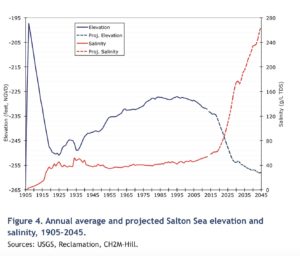One suggested short term tool to deal with the shrinking Salton Sea is to continue putting in more water. New research suggests that, for fish and birds, it won’t help.

changes in Salton Sea elevation (blue line) and salinity (red line) under current policy, courtesy Pacific Institute
“Mitigation water” is jargon for extra water currently diverted to the Salton Sea to make up for reduced agricultural runoff as efficiency improvements. (It’s hairy and I won’t try to explain the whole mess here, read my book or, if you don’t have as much time, read the Desert Sun’s recent opus, which actually does a better job on this than my book, but you should still read my book.)
As the mitigation water goes away, the sea shrinks and bad things happen, including to birds and fish. One suggestion has been to continue the flow of mitigation water past next year, when it’s scheduled to turn off. But a new analysis by a pair of Army Corps of Engineers researchers suggests that, for the birds and fish, this won’t help much, delaying but not eliminating risk to the critters as salinity in the sea keeps rising:
If no restoration action is taken in stabilizing the Sea elevation and reducing salinity but continuing QSA water transfers (at 2017 levels), i.e., scenario 2; results indicate that Salton Sea avian and fish population dynamics will be negatively impacted, although somewhat delayed.

Given that the Salton Sea has come and gone in the past it seems that a longer perspective timewise is needed. It is natural for the Salton Sea to dry up after the river flowed into it due to levee breaks. Indeed Lake Cahullia came and went on an apparent 500 to 600 year cycle. So the sea drying up is natural and has happened in the past, the ecosystem adapted to it then wny not now. The fish have died in the past and the birds moved then.
Note that the coming and going of Lake Cahullia may also be a measure of the level of precipitation in the Colorado River basin as well, as to breach the natural levees meant that there were big floods (back when the river was uncontrolled)